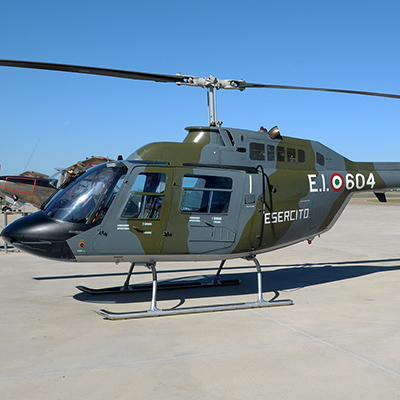Warfare
Jet Ranger
Written by: Mohsen Shirmuhammad,
Translated by: Hadi Qorbanyar
81 Views
The Jet Ranger helicopter played a key role in aerial reconnaissance and supporting Iranian troops during the Iran–Iraq War.
The AB-206 (Agusta-Bell 206) Jet Ranger, manufactured by the Italian company Agusta (under license from Boeing, U.S.), has a standard capacity of five passengers. It is powered by a single engine, capable of reaching a maximum speed of 234 km/h at sea level, with an endurance of 2 hours and 45 minutes. It can carry up to 1,500 pounds of external cargo.[1] The Jet Ranger was employed for reconnaissance, command and control, observation, artillery fire adjustment, and courier missions.[2] Due to its small size and high maneuverability, it was especially useful for reconnaissance in mountainous terrain.[3]
The Jet Ranger was first introduced into the Iranian Army Air Force in 1968.[4] In 1969, 150 units were purchased from Agusta[5] for the Army Aviation (Havanirooz), and a number of commissioned and non-commissioned officers were sent to Italy for pilot and technical training.[6] After their return, Havanirooz established the Helicopter Pilot Training School in Isfahan, where new cadets were trained exclusively on the Jet Ranger 206. Pilots from the Air Force, Police, and Gendarmerie also received training on this model.[7]
In 1975, this school was closed and replaced by the Army Aviation Training Center. At the new center, each helicopter cadet completed 110 hours of flight training on the Jet Ranger 206.[8] Commissioned and non-commissioned officers also underwent technical training on this model.[9]
In 1973, the organizational structure of Army Aviation and its subordinate units was formally approved. The operational activation of Army Aviation bases had been scheduled for 1978, but for various reasons, it was delayed and rescheduled for early 1982.[10] Jet Ranger helicopters were deployed at Kermanshah, Masjed Soleiman, and Kerman Havanirooz bases, as well as at the General Support Base in Isfahan.[11]
In 1969, alongside the introduction of the Jet Ranger 206[12] helicopter for Gendarmerie cadets, the Gendarmerie Aviation also received 14 Jet Rangers and put them into service.[13]
By 1980, Army Aviation had been equipped with 204 Jet Rangers,[14] while the Air Force operated a fleet of 6.[15] With the outbreak of war on September 22, 1980, a large number of helicopters, including Jet Ranger 206s from the Isfahan, Kerman, and Masjed Soleiman bases, were dispatched to Khuzestan. For example, during the first seven days of the war in the western regions of Dezful and Shush, the 206s, alongside other Army Aviation helicopters, logged 835 operational flight hours.[16] Jet Rangers conducted reconnaissance missions over the battle zones to identify enemy positions and, in some cases, transported senior army commanders to the frontlines, allowing them to directly observe the enemy’s situation.[17]
With the start of the major operations to liberate Khuzestan, Havanirooz, together with other units of the Army and the Islamic Revolutionary Guard Corps (IRGC), played an active role in the battlefronts. During Operation Thamen al-Aemmah (as) and the breaking of the siege of Abadan in September 1981, 46 helicopters—including two Jet Rangers from the Kerman Base—flew a total of 600 hours in support of the Iranian forces.[18]
In November-December 1981, during Operation Tariq al-Quds, 40 Army Aviation helicopters—including one Jet Ranger from the Masjed Soleiman Base and one from the General Support Base in Isfahan—flew 1,483 hours and transported 4,862 Army and IRGC personnel.[19]
In March 1982, during Operation Fath al-Mubin and the liberation of Bostan, four Jet Rangers from the Kerman Base, four from Masjed Soleiman, and four from Isfahan participated in the operation. Along with other Army Aviation helicopters, they carried out 3,500 sorties and transported 2,840 Iranian forces.[20]
During Operation Beit al-Muqaddas in April-May 1982, which led to the liberation of Khorramshahr, Havanirooz deployed 95 helicopters, including five Jet Rangers from Isfahan, two from Masjed Soleiman, and six from Kerman. Together, they flew 5,180 hours in support of Iranian forces.[21]
Army Aviation played a major logistical support role in Operation Kheibar that took place in February 1984, to capture the Majnoon Islands in the Hoor al-Azim marshes.[22] A total of 98 helicopters,[23] including two Jet Rangers from the Kerman Base, two from Masjed Soleiman, and two from Isfahan,[24] carried out 1,291 flight hours and transported 19,400 Army and IRGC troops into the Majnoon Islands.[25]
Also, two Bell 206 Jet Rangers from the General Support Base in Isfahan participated in Operation Badr over the Majnoon Islands in March 1985.[26]
In Operation Valfajr 8, which was led by the IRGC and resulted in the capture of Al-Faw, Army Aviation deployed 80 helicopters, including one Jet Ranger from Isfahan, two from Kerman, and two from Masjed Soleiman. Totally, they flew 3,938 hours in support of Iranian forces.[27]
The last recorded combat use of the Jet Ranger during the war was in Operation Mersad in July 1988, when four Jet Rangers from the Kermanshah Base flew 425 hours and airlifted 3,360 forces to the battlefield alongside other Army Aviation helicopters.[28]
The IRGC Air Unit was also equipped with two Jet Rangers in 1982. That same year, after the overhaul of two helicopters by the Iran Helicopter Support and Renovation Company industries and two more by IRGC specialists, the number of Jet Rangers in the IRGC Air Unit reached six. Their first mission was in Operation Kheibar, where they carried out reconnaissance flights.[29] Beginning in 1983, following the completion of the first IRGC pilot training course and the conclusion of Operation Kheibar, the IRGC helicopter unit formally began operational activity. Until the end of the war, it carried out two main tasks with the Jet Rangers: training and participation in combat operations.[30]
In total, Jet Ranger helicopters logged 11,000 flight hours during the Iran–Iraq War.[31]
In 1988, the Defense Industries Organization completed the unfinished Bell Textron factory (originally established by the United States) for the domestic production and supply of helicopters in Iran. Today, this facility operates in both fixed-wing and rotary-wing divisions, manufacturing helicopters, airplanes, and their components, including the Jet Ranger.[32] Moreover, Iran Helicopter Support and Renovation Company, affiliated with the Ministry of Defense, is responsible for conducting major overhauls of the Jet Ranger fleet.[33]
After the war, in 2001, the Shahed 278 helicopter was designed and produced by the IRGC as the first Iranian helicopter modeled after the Jet Ranger. It has since been used for training, air rescue, and police patrol missions.[34]
Nowadays, the airframe and fuselage of the Bell 206 are also manufactured domestically by the Iran Helicopter Support and Renovation Company.[35]
[1] Yari, Houshang, Havanirooz: Negahi be Gozashteh, Hal va Ayandeh (Army Aviation: A Look at the Past, Present, and Future), Sureh-ye Sabz, 1392, Pp. 84–85.
[2] Ardeshirzadeh, Karim, Hamaeseh-ha-ye Mandegar-e Havanirooz dar Defa Muqaddas (Enduring Epic of Army Aviation in the Sacred Defense), Tehran, Navid Tarhan, 1388, p. 256.
[3] Pourbozorg Vafi, Ali-Reza, Sejil-e Atash, Vol. 1 (Sejil of Fire), Sazman-e Aqidati Siyasi-ye Artesh, 1380, p. 63.
[4] Nirooye Havaei dar Defa Muqaddas (Army Air Force in the Sacred Defense), Tehran, Iran Sabz, 1st ed., 1389, p. 19.
[5] Maaref-e Jang (War Knowledge), Tehran, Entesharat-e Iran Sabz, 1393, p. 256.
[6] Ibid., p. 256.
[7] Yari, Houshang, Ibid., p. 168.
[8] Ibid., p. 169.
[9] Ibid., p. 170.
[10] Maaref-e Jang (War Knowledge), p. 256.
[11] Ibid., Pp. 258–259.
[12] Shahmuhammadi, Hojjat, Tarikhche-ye Havanirooz az Peidayesh ta Takamol (History of Army Aviation from Inception to Development), Tehran, Nashr-e Shahid Saeed Mohebi, 1382, Pp. 167–169.
[13] Qaem-Maqami, Jahangir, Tarikh-e Jandarmeri-ye Iran (History of the Iranian Gendarmerie), Tehran, Jandarmeri, 1355, p. 432.
[14] Darvishi, Farhad, Tajziye va Tahlil-e Jang-e Iran va Araq, Vol. 1: Risheha-ye Tahajom (Analysis of the Iran–Iraq War, Vol. 1: Roots of the Aggression), Tehran, Markaz-e Motaleat va Tahqiqat-e Jang, 1378, p. 95.
[15] Zeinli, Nasrollah, Amad va Poshtibani-ye Havaei dar Defa Muqaddas (Air Preparedness and Support in the Sacred Defense), Tehran, Markaz-e Entesharat-e Rahbordi-ye NAHAJA, 1394, p. 266.
[16] Ardeshirzadeh, Karim, Ibid., p. 25.
[17] Yari, Houshang, Ibid., p. 106.
[18] Ardeshirzadeh, Karim, Ibid., Pp. 51, 54.
[19] Ibid., Pp. 55–56.
[20] Ibid., Pp. 64–65.
[21] Ibid., Pp. 67, 71.
[22] Yari, Houshang, Ibid., p. 122.
[23] Ardeshirzadeh, Karim, Ibid., p. 101.
[24] Ibid., p. 96.
[25] Ibid., p. 101.
[26] Ibid., p. 103.
[27] Ibid., Pp. 111, 115.
[28] Ibid., p. 167.
[29] Didar-e Asemani-ye Nirooye Havaei-ye Sepah, Tir 82 (Heavenly Visit of the IRGC Air Force, 2003), Moavenat-e Farhangi-ye Nirooye Havaei-ye Sepah Pasdaran, Mordad 1382, p. 16.
[30] Yari, Houshang, Ibid., p. 174.
[31] Maaref-e Jang (War Knowledge), p. 276.
[32] Ibid., p. 257.
[33] Sait-e PANHA (Iran Helicopter Support and Renovation Company), www.panha.ir/#services
[34] Ashnaei ba Balgard-e Shahed 278 (Introduction to the Shahed 278 Helicopter), Sherkat-e Sanaye-ye Havapeymasazi-ye Iran, 23 Khordad 1402, www.hesa.ir/hesa/home/Note/105166
[35] Balgardha-ye Iran dar Koja Poshtibani va Nowsazi Mishavand (Where Iran’s Helicopters are Supported and Renovated), Khabargozari Tasnim News, 5 Shahrivar 1399, www.tasnimnews.com/fa/news/1399/06/05/2335350





